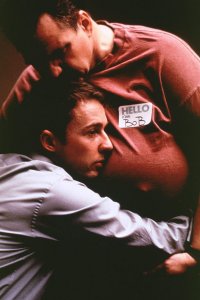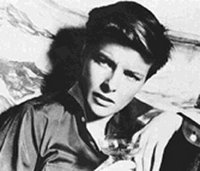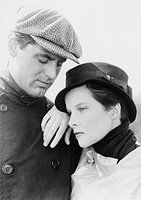Now that I’m all queered up from writing about Fight Club, I want to explore the uses of and distinctions between “queer” and “bisexual” a bit. I have no problem saying Fight Club is more (repressed) gay (narrator and/with Tyler) or queer (Bob, narrator’s relationship with Bob) than bisexual, even though bisexual is not inaccurate in terms of the desires (gay/queer) and actions (straight-ish) shown in the film. What makes me want to use one term over another?
Like Alexander Doty, whose work I thoroughly enjoy, I like the term “queer” to “describe non-straight things that are not clearly marked as gay, lesbian, bisexual, transsexual, or transgendered” (Doty, “Introduction” to Flaming Classics: Queering the Film Canon, p.7). As the narrator of Fight Club – to stay with this example a little longer since it’s handy – dates the significant change in his life (his psychotic split, which queers him, arguably) to being pressed into Bob’s maternal male breasts (though he immediately decides to re-date and change his flashback, addressing well his anxiety and need to repress and re-repress his “non-straight” attractions), I see queerness as taking up central space in the narrative. Bob is neither straight, gay, bi, or trans. He’s a castrated male (not his choice) with cock and hormone-induced breasts, macho past, anxiety about the change to queerness, and tendency to tears. (Casting Meat Loaf adds to the queerness, of course.) The more the narrator is drawn to Bob – culminating in his breakdown over Bob’s dead body in his paper house/compound – the more he breaks from easy categorization. To me, the easier the categorization, the less queer.
flashback, addressing well his anxiety and need to repress and re-repress his “non-straight” attractions), I see queerness as taking up central space in the narrative. Bob is neither straight, gay, bi, or trans. He’s a castrated male (not his choice) with cock and hormone-induced breasts, macho past, anxiety about the change to queerness, and tendency to tears. (Casting Meat Loaf adds to the queerness, of course.) The more the narrator is drawn to Bob – culminating in his breakdown over Bob’s dead body in his paper house/compound – the more he breaks from easy categorization. To me, the easier the categorization, the less queer.
So perhaps that’s where I’m at presently: queer is harder to categorize than bisexuality. This does not mean bisexuality is simple. Doty, in an analysis of Gentlemen Prefer Blondes as the uber-bisexual musical, cites critic Chris Cagle as distinguishing between “straight-identified bisexuals” and “queer-identified bisexuals.” Straight-identifiers are those who maintain primary relationships with partners of the opposite sex and enjoy shorter-term or “on the side” relationships with same-sex partners. These bisexuals, argues Cagle, can then “enjoy the protection of straight privilege” (Doty, Flaming Classics, p.149). This distinction may be too binary for some, and it does not help me define queerness. Why “queer-identified” bisexual rather than “lesbian/gay-identified” bisexual?
Is lesbian, gay, bisexual, or straight about how you partner up and queer how you may choose to identify beyond partners/relationships?
To take another tack, what is the opposite of queer? At the moment, I’d argue there is no opposite, and that this is the attraction of queerness.

I’ve recently begun working on a manuscript that explores relationship triangles in three romantic comedies directed by out-gay Hollywood studio director George Cukor. In all three films, Katharine Hepburn is at the center, playing a character who breaks from traditional femininity. Cary Grant is at her side, part of the triangle. The third member is a more orientationally ambiguous male that brings queerness into the romance (or makes the queerness more overt). In Sylvia Scarlett, it’s Brian Aherne’s Michael Fane, an artist and bohemian who comes to love Hepburn’s character best when she’s dressed as a boy. In Holiday, it’s Hepburn’s brother, the perhaps-gay alcoholic brother who is forced to tow the family line as the only son of a wealthy, tyrannical father. In The Philadelphia Story it’s Jimmy Stewart’s marriage-resistant Macaulay Conner, the reporter who falls for Hepburn’s Tracy Lord only because, I’d argue, she’s beloved of Cary Grant’s C.K. Dexter Haven – the real figure of mystery and intrigue for Conner.
makes the queerness more overt). In Sylvia Scarlett, it’s Brian Aherne’s Michael Fane, an artist and bohemian who comes to love Hepburn’s character best when she’s dressed as a boy. In Holiday, it’s Hepburn’s brother, the perhaps-gay alcoholic brother who is forced to tow the family line as the only son of a wealthy, tyrannical father. In The Philadelphia Story it’s Jimmy Stewart’s marriage-resistant Macaulay Conner, the reporter who falls for Hepburn’s Tracy Lord only because, I’d argue, she’s beloved of Cary Grant’s C.K. Dexter Haven – the real figure of mystery and intrigue for Conner.
(I cannot tell you why Hepburn looks like a curly-headed lesbian priest in this picture. But isn't his cravat delightful?)
Regardless of whether you find my angle compelling here or not, what I’m puzzling over at the moment is whether I’m writing about bisexuality or queerness. I’d argue everything in Sylvia Scarlett points to queerness, including Aherne’s immortal line, “There’s something queer when I look at you” as he gazes at Hepburn in drag as the youth Sylvester Scarlett. Yet Doty, in a footnote in his Gentlemen Prefer Blondes chapter, calls Fane "bisexual." As I wrestle with why Fane is bisexual not queer or bisexual and queer or queer not bisexual, I find myself concocting definitions by the score. Fane is clearly attracted to women, never actively attracted to men other than Sylvia/Sylvester, yet ends the film happiest when with Sylvia fully disguised as Sylvester (ostensibly in disguise as part of their effort to find Fane’s ex-girlfriend who has run off with Grant’s con artist Jimmy Monkley). Now, that complex kind of attractio n could be described as bisexual, though Fane is in such a case closeted/repressed about his own homosexual desires. But if it’s a woman in drag he’s most drawn to, then to me that’s more queer. More easily labeled bisexual is probably Grant’s Monkley, who, when thinking Hepburn’s character is definitely male, suggests he’d make a “proper little hot water bottle” to sleep beside when they’re on the road.
n could be described as bisexual, though Fane is in such a case closeted/repressed about his own homosexual desires. But if it’s a woman in drag he’s most drawn to, then to me that’s more queer. More easily labeled bisexual is probably Grant’s Monkley, who, when thinking Hepburn’s character is definitely male, suggests he’d make a “proper little hot water bottle” to sleep beside when they’re on the road.
To be sure, my angle on these three films is in seeking out queerness, romantic triangles that break with conventional sexualities, even straight/bi/gay distinctions. So I’m looking at/for queerness rather than bi or gay “subtext” in the films. I think.
When, mid-footnote, Doty uses the phrase “gender queerness and bisexuality” as at the heart of Sylvia Scarlett’s romantic conclusion (p.153), I’m pondering again. Here queerness is about gender and bisexuality is about orientation. I guess this works, but it’s still another binary that doesn’t fully get to Fane falling in love not with a young man or even a woman in drag: he’s falling for genderfuck, I think. But that’s yet another term to ponder....
Work Cited
Doty, Alexander. Flaming Classics: Queering the Film Canon. NY: Routledge, 2000.
Like Alexander Doty, whose work I thoroughly enjoy, I like the term “queer” to “describe non-straight things that are not clearly marked as gay, lesbian, bisexual, transsexual, or transgendered” (Doty, “Introduction” to Flaming Classics: Queering the Film Canon, p.7). As the narrator of Fight Club – to stay with this example a little longer since it’s handy – dates the significant change in his life (his psychotic split, which queers him, arguably) to being pressed into Bob’s maternal male breasts (though he immediately decides to re-date and change his
 flashback, addressing well his anxiety and need to repress and re-repress his “non-straight” attractions), I see queerness as taking up central space in the narrative. Bob is neither straight, gay, bi, or trans. He’s a castrated male (not his choice) with cock and hormone-induced breasts, macho past, anxiety about the change to queerness, and tendency to tears. (Casting Meat Loaf adds to the queerness, of course.) The more the narrator is drawn to Bob – culminating in his breakdown over Bob’s dead body in his paper house/compound – the more he breaks from easy categorization. To me, the easier the categorization, the less queer.
flashback, addressing well his anxiety and need to repress and re-repress his “non-straight” attractions), I see queerness as taking up central space in the narrative. Bob is neither straight, gay, bi, or trans. He’s a castrated male (not his choice) with cock and hormone-induced breasts, macho past, anxiety about the change to queerness, and tendency to tears. (Casting Meat Loaf adds to the queerness, of course.) The more the narrator is drawn to Bob – culminating in his breakdown over Bob’s dead body in his paper house/compound – the more he breaks from easy categorization. To me, the easier the categorization, the less queer.So perhaps that’s where I’m at presently: queer is harder to categorize than bisexuality. This does not mean bisexuality is simple. Doty, in an analysis of Gentlemen Prefer Blondes as the uber-bisexual musical, cites critic Chris Cagle as distinguishing between “straight-identified bisexuals” and “queer-identified bisexuals.” Straight-identifiers are those who maintain primary relationships with partners of the opposite sex and enjoy shorter-term or “on the side” relationships with same-sex partners. These bisexuals, argues Cagle, can then “enjoy the protection of straight privilege” (Doty, Flaming Classics, p.149). This distinction may be too binary for some, and it does not help me define queerness. Why “queer-identified” bisexual rather than “lesbian/gay-identified” bisexual?
Is lesbian, gay, bisexual, or straight about how you partner up and queer how you may choose to identify beyond partners/relationships?
To take another tack, what is the opposite of queer? At the moment, I’d argue there is no opposite, and that this is the attraction of queerness.

I’ve recently begun working on a manuscript that explores relationship triangles in three romantic comedies directed by out-gay Hollywood studio director George Cukor. In all three films, Katharine Hepburn is at the center, playing a character who breaks from traditional femininity. Cary Grant is at her side, part of the triangle. The third member is a more orientationally ambiguous male that brings queerness into the romance (or
 makes the queerness more overt). In Sylvia Scarlett, it’s Brian Aherne’s Michael Fane, an artist and bohemian who comes to love Hepburn’s character best when she’s dressed as a boy. In Holiday, it’s Hepburn’s brother, the perhaps-gay alcoholic brother who is forced to tow the family line as the only son of a wealthy, tyrannical father. In The Philadelphia Story it’s Jimmy Stewart’s marriage-resistant Macaulay Conner, the reporter who falls for Hepburn’s Tracy Lord only because, I’d argue, she’s beloved of Cary Grant’s C.K. Dexter Haven – the real figure of mystery and intrigue for Conner.
makes the queerness more overt). In Sylvia Scarlett, it’s Brian Aherne’s Michael Fane, an artist and bohemian who comes to love Hepburn’s character best when she’s dressed as a boy. In Holiday, it’s Hepburn’s brother, the perhaps-gay alcoholic brother who is forced to tow the family line as the only son of a wealthy, tyrannical father. In The Philadelphia Story it’s Jimmy Stewart’s marriage-resistant Macaulay Conner, the reporter who falls for Hepburn’s Tracy Lord only because, I’d argue, she’s beloved of Cary Grant’s C.K. Dexter Haven – the real figure of mystery and intrigue for Conner.(I cannot tell you why Hepburn looks like a curly-headed lesbian priest in this picture. But isn't his cravat delightful?)
Regardless of whether you find my angle compelling here or not, what I’m puzzling over at the moment is whether I’m writing about bisexuality or queerness. I’d argue everything in Sylvia Scarlett points to queerness, including Aherne’s immortal line, “There’s something queer when I look at you” as he gazes at Hepburn in drag as the youth Sylvester Scarlett. Yet Doty, in a footnote in his Gentlemen Prefer Blondes chapter, calls Fane "bisexual." As I wrestle with why Fane is bisexual not queer or bisexual and queer or queer not bisexual, I find myself concocting definitions by the score. Fane is clearly attracted to women, never actively attracted to men other than Sylvia/Sylvester, yet ends the film happiest when with Sylvia fully disguised as Sylvester (ostensibly in disguise as part of their effort to find Fane’s ex-girlfriend who has run off with Grant’s con artist Jimmy Monkley). Now, that complex kind of attractio
 n could be described as bisexual, though Fane is in such a case closeted/repressed about his own homosexual desires. But if it’s a woman in drag he’s most drawn to, then to me that’s more queer. More easily labeled bisexual is probably Grant’s Monkley, who, when thinking Hepburn’s character is definitely male, suggests he’d make a “proper little hot water bottle” to sleep beside when they’re on the road.
n could be described as bisexual, though Fane is in such a case closeted/repressed about his own homosexual desires. But if it’s a woman in drag he’s most drawn to, then to me that’s more queer. More easily labeled bisexual is probably Grant’s Monkley, who, when thinking Hepburn’s character is definitely male, suggests he’d make a “proper little hot water bottle” to sleep beside when they’re on the road.To be sure, my angle on these three films is in seeking out queerness, romantic triangles that break with conventional sexualities, even straight/bi/gay distinctions. So I’m looking at/for queerness rather than bi or gay “subtext” in the films. I think.
When, mid-footnote, Doty uses the phrase “gender queerness and bisexuality” as at the heart of Sylvia Scarlett’s romantic conclusion (p.153), I’m pondering again. Here queerness is about gender and bisexuality is about orientation. I guess this works, but it’s still another binary that doesn’t fully get to Fane falling in love not with a young man or even a woman in drag: he’s falling for genderfuck, I think. But that’s yet another term to ponder....
Work Cited
Doty, Alexander. Flaming Classics: Queering the Film Canon. NY: Routledge, 2000.


7 comments:
Fab post. Two thoughts:
(1) Could you find a way to include Bringing Up Baby so you could discuss Grant "going all gay all of a sudden"?
(2) How do you factor fetishism into queerness? My experience is that gay and straight fetishists often have a common ground that allows them to identify with one another as equally queer, in part because their queerness separates them from their non-fetishistic friends within their respective orientation groups. (That is, a BDSM lesbian may feel more identified with a BDSM straight than with a "vanilla" lesbian.)
I think queerness exists, at least in part, outside orientation. You cite attraction to cross-dressing as being more queer than bisexual, and that's part of what I mean; it doesn't matter what gender you are if you're attracted to a cross-dresser; it's queer and not about orientation.
This post and the last (on Fight Club, which I dismissed as a crappy, worthless movie until I read your blog and now have to re-think and re-see the film) remind me of how remarkable a sister I have and how much I learn from you. (-:
Reid
DEBORAH:
(1) Sadly, Bringing Up Baby was directed by Howard Hawks, not George Cukor. (That said, Hawks also directed Gentlemen Prefer Blondes, so there's queerness in his films too. I'd have to spend a little time trying to get queerness out of His Girl Friday but I love a challenge.
(2) I agree, yet I find less kink in older films than same-sex attractions/subtext. I am unaware of folks into BDSM calling themselves queer (via their BDSM), actually. I can think of some pretty uptight homophobes, for example. Tell me more.
And yes, queerness does seem to encompass both gender and sexual orientation -- or perhaps exceeds them.
REID: Wow, thanks :) That makes me feel awesome. Let me know what you think when you re-see Fight Club, keeping in mind that millions of viewers found it simply a "cool flick about dudes fighting" or a "thriller about a guy who goes nuts" (hence validating your feeling that it's crap).
Elyce
I am unaware of folks into BDSM calling themselves queer (via their BDSM), actually. I can think of some pretty uptight homophobes, for example. Tell me more.
Well, there are straight BDSM couples who play at gay clubs, and vice versa. Provided it's not a closed event, it's pretty common.
The primary orientation for many BDSM people seems to be BDSM. I certainly know straight or gay men or women who will "play" with someone not of their orientation, but won't have sex outside their orientation. That is, I know a lesbian dom who will happily flog men or women, but only forms relationships with women.
Events and clubs for BDSM folks used to be very strictly segregated by orientation. Some still are, but many aren't. Queer is an inclusive identity that allows recognition that a sexuality that differs from the straight and narrow is more important than what that identity is.
I agree you won't find much fetish subtext in older movies. In fact, it's still not acceptable most of the time, even today. Secretary is something of the exception that proves the rule.
I'm sorry I forgot about Hawks. I think it would be pretty easy to queer up His Girl Friday. Rosalind Russell is pretty butch, and her new fiance is clearly being dominated by her.
There are several vital reasons why I think the term queer is far more inclusive and accurate than bisexual.
Bisexual inherently presupposes two sexes, which as Anne Fausto-Sterling in Sexing the Body, among other works, has shows in not even "biologically" accurate. More importantly, by assuming the dichotomy of the sexes, the term bisexual is itself gender normative, and I argue, therefore, supports the erasure of other genders that do not fit into either category.
Finishing second in the phone sex recording Olympics gets you silver. phone sex recording
That will be proud to be bisexual, but its difficult to come out as bisexual
Post a Comment